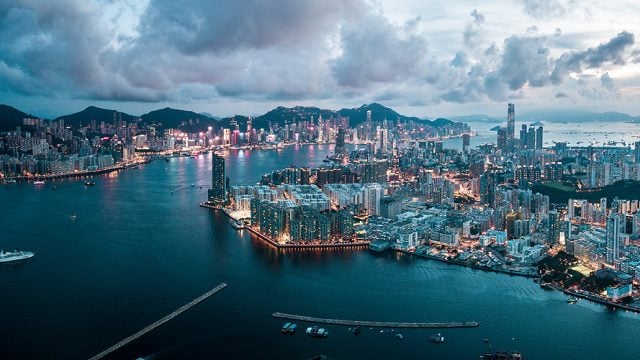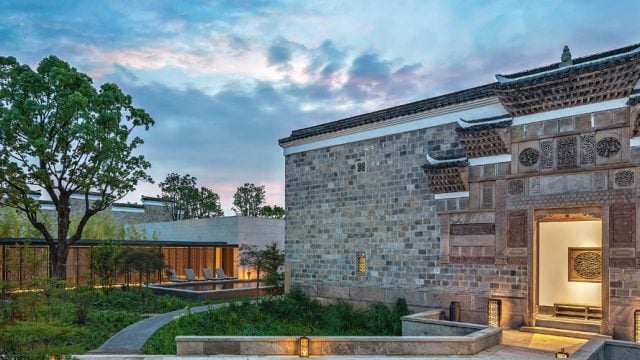There are no camels on the streets of Xi’an, a thoroughly modern metropolis. But after a month
The flavours here are distinctly un-Chinese. Strolling down bazaars in the Muslim Quarter, I try fat-tailed sheep kababs on wooden skewers cooked by ladies running roadside grills; the next course is mince pies that are a bit like samosas… ah, the irresistible delicacies of Central Asia!
By the time I’ve had my fill I spot another woman carefully cracking tiny eggs on to skewers laid across a cast-iron frying pan with small dents in it — quail-egg kababs! Then there’s the local burger, rou-jia-mo, finely chopped stewed meat in pita bread. It’s a food-festival day and night, and the smells… ah, the smells in streets like Damaishi, of roasting spices, frying breads and grilling meats, remind me of Old Delhi. But with a Chinese twist.
These alleys, today lined with souvenir stalls, would have once been home to warehouses which held goods to be transported westward until a caravan came to pick them up, while merchandise bound for eastern China was offloaded for onward distribution. The international trade seems to have begun well before the year dot and lasted for a millennium and a half, after which Xi’an became a provincial town.
This Muslim Quarter certainly existed already during the cosmopolitan Tang dynasty (AD 618-907) as a settlement for foreign traders. Settle they did and in sufficiently large numbers for a mosque, Daxue-Xixiang, to be built as early as AD 705, followed by the Great Mosque Huajuexiang Qingzhen Dasi forty years later. The fact that mosques stood virtually next door to the emperor’s palace indicate that foreigners were welcome guests, and remain tangible evidence that Xi’an was a multicultural city. And, if one is to believe the sign atop the nearby Westgate watchtower, the exact starting point of the Silk Road lay right around the corner.
Just think. There’s nothing unusual about the early arrival in Xi’an of a distant religion like Islam. Buddhism arrived at an even earlier (unknown) date and in the latter half of the first millennium it was well established. A Nestorian Christian church was erected by Syrians outside town in c. AD 638, Manichaeism arrived with Persian traders in c. AD 694 and Zoroastrians seem to have been around too. They were all allowed to set up places of worship, though only the Buddhist pagodas and Muslim mosques stand today.
The dates of these religious imports mark times when the Silk Road was hot and happening. The Silk Road wasn’t just a route between China and the Mediterranean countries. For the Chinese, it was a trade channel that brought in attractive products from many countries such as Ayurvedic herbs reputed to bring immortality, spices, incense, cotton and sandalwood. Some would say that the most important commodity that travelled along this route was rather intangible, namely, ideas — especially Buddhism, but also technical know-how. Aside from gunpowder, porcelain and the compass, Chinese technology that was exported included printing and paper-making.
As a cultural hub, Xi’an is not only one of the oldest surviving cities of the world, but it was also the greatest for some time — in the eighth century, its population peaked at two million, 5,000 of whom were registered as foreigners. A commercial city of palace-lined avenues congested with jade palanquins, bearded businessmen, fair blond ladies and Indian mendicants in chappals, and a great centre for learning.
Take a look at it from above. The massive walls — early Ming dynasty (fourteenth century) built atop Tang walls — are tourist attractions that afford views of the hustle-bustle within and without. The top is as wide as a road. It takes about half a day to do the whole length on foot. The entrance is through the main gates. Signboards point out sights, such as the Temple of Literature, and when you tire there’s the odd coffee bar.
You realise how huge the city was, much bigger than the existing walls indicate, if you go to the basement of the Xi’an Museum, next to the Little Wild Goose Pagoda, where there’s a 1:1500 model of the Tang city with a grid of avenues dividing it into some hundred residential districts covering eighty-four square kilometres.
Also worth checking out is the Forest of Stelae Museum, housed in a Confucian temple. Stelaes were the cyclostyle machines of prehistoric times and an important accessory to scholarship and educational activities: rubbings were made and anybody could basically carry home an ancient Xerox — the collection includes everything from sacred scriptures to poetry, dictionaries and Xi’an city maps. The Stone Sculpture Art Gallery holds more curious things: Indian-looking Tang-era statuary, excavated from the Anguo temple (razed by an anti-Buddhist emperor), includes a Devaraja who even wears a proper dhoti.
Considering its position as the imperial centre, the landscape surrounding Xi’an is, not surprisingly, dotted with mausoleums built for illustrious royalty and filled with opulent treasures guarded by ingenious traps. The best known is Qin Shi Huang’s (d. 210BC) tomb. Builder of the Great Wall and unifier of China, and totally brutal, he demanded to be protected in the afterlife by 8,000 life-sized clay soldiers. The army would have been even more spectacular if you saw it 2,000 years ago — the warriors painted in bright colours, armed to their teeth.
Naturally, a city like this became a nodal point for Buddhism. The religion came here early, at the latest by AD 300 but possibly much earlier, in a form that had adjusted to local tastes as it travelled along the trading routes over centuries.
The earliest Buddhist celebrity came from the oasis kingdom of Kucha, in what is now the Uyghur region of modern China. Kumarajiva, born AD 344, was the son of a high-ranking Kashmiri-Brahmin officer at the Kucha court, who had married a local princess. His parents sent him to India to study, where, thanks to his encyclopaedic mindset, he learnt the Vedas, occultism and Buddhism — the last of which he was acknowledged to be an expert on.
When the Chinese emperor heard of this valuable asset he sent an army to the Kucha Oasis to capture the celebrity monk, and Kumarajiva ended up in Xi’an in AD 401 where he was invited to start a translation workshop. By this time Buddhism had gained a foothold and the Chinese wanted to get a more accurate understanding of it. (Coincidentally, at almost exactly the same time the monk, Faxian, set off on a ten-year-long study tour, writing the first known detailed travel guide for pilgrims to India.)
With the support of the emperor, Kumarajiva (better known as Jiumoluoshi in Chinese) set up a thatch-roofed ashram thirty-five kilometres outside town, within a Qin-era imperial garden where 3,000 translators reworked the major Buddhist texts into Chinese. He died in AD 413, almost seventy years old.
I rent a cab to go and see Kumarajiva’s ashram. Unlike most locals, the driver, Peter, speaks English. (Xi’an today is less multicultural than it was 1,500 years ago.) I reflect aloud on the fact that we are driving through endless suburbs with building cranes looming tall over half-built highrises.
“Xi’an 8.4 million people,” says Peter.
“Very big,” I compliment him.
“In China, so-so,” says Peter.
The ashram, known as the Caotang temple, is set amid bamboo groves and corn fields within sight of the bluish Guifeng foothills, a minor tourist attraction with its cluster of temples dwarfing the octagonal funerary pavilion. I finally locate it next to a Tang-era stele listing Kumarajiva’s disciples, plus a well which provided drinking water to the 3,000 translators. After his cremation, Kumarajiva performed one last feat. A lotus flower grew out of the well, and when pulled at, the master’s tongue popped out, joined to the lotus stem, still waggling as if busy translating!
The compound hosts another miraculous well which emits fog even on sunny days, its puffs puzzling the Chinese tourists. With my background in theatre, however, I identify the gently pumping sound of a smoke machine.
Two hundred years later, in AD 602, Xuanzang (Hsüan-tsang), was born near Luoyang. He distinguished himself by being a precocious bookworm. When he first came to Xi’an in his teens, the population would already have been one million. By then Buddhism had been adopted as state religion by the Sui dynasty. Although Xuanzang spent many years in a monastery, he was drawn back to Xi’an to learn foreign languages. There were enough interpreters around and he spent a year taking Sanskrit classes to prepare for India.
What had disturbed him in the monastery was that Chinese Buddhism was tainted with syncretic influences picked up along the Silk Road, and further mixed with indigenous beliefs. Monks like Kumarajiva were regarded as wizards and Nirvana was equated with immortality that could be attained through yoga. Doubting the authenticity of what he was being taught, Xuanzang’s solution was to look for the source — which made it necessary to travel to India.
At the approximate age of twenty-seven, using Faxian’s travelogue as a guide, Xuanzang sneaked off one night, according to legend, through the West Gate. He walked along the Silk Road for a considerable distance, through the Taklamakan desert, until he reached Samarkand where he turned left towards Bactria (and saw the Bamiyan Buddhas). By the time he got to India he had walked an astonishing 6,000 kilometres in four years.
When I Google the best route today, the software sends me on a wild-goose chase, an 11,625-kilometre detour skirting Mongolia and advises me to ‘Use caution — This route may be missing sidewalks or pedestrian paths’, before the computer hangs.
Xuanzang’s long sojourn in India is well known. He wrote a lengthy report not only detailing the condition of Buddhist sites such as Na Lan Tuo (Nalanda), but also sharing useful geographical information and describing trade opportunities. His Journal of West Countries in Tang Dynasty (completed in AD 646) is perhaps the best first-millennium guide to backpacking in India and still in print as a valuable resource for archaeologists unearthing India’s past. Apart from the report, Xuanzang brought back — courtesy of the pious Indian maharaja, Harsha — a caravan of elephants carrying 657 manuscripts, seven Buddha statues and 150 sacred relics, such as bits of Buddha’s flesh and a box full of Buddha’s bones.
The premier tourist sight in Xi’an is actually the Giant Wild Goose Pagoda, the library built in AD 652 to house Xuanzang’s collection. He personally oversaw its construction as a fireproof storage space for his manuscripts while his translation workshop was housed in the Da Ci’en temple just behind the pagoda. In the temple, modern murals depict the monk’s journey and huge display cases in two halls contain copies of his translations, although there is no trace left of all the actual materials he brought back.
The pagoda is especially imposing once you climb up — there are 249 steps and the view is outstanding even now and must have been more so 1,300 years ago when skyscrapers hadn’t been invented. Sitting at the top, the noisy city seems like a mirage. One realises how charmless big cities are — an endless tedium of construction sites and wide roads with too much traffic, whereas tourists come looking for a past that most locals have put behind them. But the city wasn’t charming to Xuanzang either. Within a year and a half he moved off to the Jade Flower Palace, ninety-five kilometres north. A decade later, on January 5, 664, he died. Before his death a disciple asked Xuanzang if he would return in a future life. “Quite sure,” he is reported to have said.
Millions came to his funeral and some 30,000 refused to leave the spot afterwards. First he was interred outside the city walls, but the emperor found the view of the mourners depressing, so within five years another burial spot was chosen — anyway, Xuanzang didn’t want his remains to be near palaces or monasteries, and his final resting place reflects this ideal.
The Xingjiao Pagoda (Temple of Booming Learning) twenty kilometres south, hasn’t yet been swallowed by Xi’an’s growing suburbs. You drive up a hill and find a delightful complex with several courtyards originally laid out in AD 669, though most of it was rebuilt after recent twentieth-century donations. But the Tang-era pagoda on top of the monk’s remains, the oldest brick pagoda in China, is more or less the same today. If you bend low when kneeling before the pagoda, you catch a glimpse of the colourful, Qing-dynasty life-sized clay statue of the monk inside.
This was the end of the road for the travelling monk, but it wasn’t where his journey ended. His translations went on to flourish and, at a point when Buddhist source texts started to become scarce, made their way back to India. Posthumously, Xuanzang became something of a Buddha himself; his relics too, like Lord Buddha’s a thousand years before him, were distributed around China and deposited in important places. A piece of his skull eventually ended up in the collections at the Archaeological Museum in Patna, almost as if to prove that there’s life after death.
Especially if you’re a translator. Or a good travel writer.
The information
Getting there
The cheapest and most convenient airline would be Air China, with connections from almost all over India (about Rs 30,500 return). The journey usually includes a stop at an air hub such as Chengdu. From Beijing and Shanghai, there are comfortable overnight trains — return will cost about 1,000RMB in sleeper class.
Visa
A single-entry visa costs Rs 3,000 and takes about 4 working days.
Currency
The Chinese currency is the yuan or renminbi (RMB). 1RMB=Rs 10.2.
Getting around
Within Xi’an’s old town and its vicinity it is perfectly nice to walk, but if you get fed up flag down an autorickshaw, often driven by women. For sites outside town — such as described in the article — you can go to all of them by bus if time permits (there are buses for the Terracotta Warrior site from outside the railway station), but it is somewhat cumbersome since nobody knows English and it may be easier to hire a taxi. I hired an English-speaking driver, Peter Liu, from Shaanxi Tourism Automobile Company (+86-13909257289) for a day at 900RMB.
Where to stay
Several multinational hotel brands, such as Sofitel, Hilton, Kempinski and Shangri-la have properties in Xi’an. But I stayed at the reasonably priced, classic hotel Bell Tower (Zhonglou Fandian), located right by the eponymous Bell Tower on 110 Nan Daijie in the Walled City (from 460RMB; belltowerhotelxian.cn). If you’re on a budget, the old town has many great, cheap hotels: I got a gorgeous room in a friendly hotel called YongCun Fandian on 65 Jianguo Road (approx. 230RMB; +86-29-87449773). At all cost avoid hotels outside the city walls or you’ll end up not enjoying your stay and instead worrying about transport all the time.
Where to eat
If you’re a street-foodie you’ll hit bull’s eye by strolling the alleys of the Muslim Quarter where both vegetarian and non-vegetarian delicacies are on sale for a fistful of coins. The less touristy alley is Damaishi Jie with several cheap places doing awesome spicy noodles and grilled chickens; a smashing dish might cost 7RMB.
Outside the Muslim Quarter, among the most famous old restaurants is Lao Sun Jia, a chain that specialises in local delicacies such as yangrou paomo, crumbed bread in mutton stew (30RMB). Before you go it is good to know the system: the waiter will give you bread and an empty bowl, and you shred the bread into as small bits as possible before your bowl is filled with stew. There’s a convenient branch on the road leading east from East Gate, at the end of the first block — spot it by the sign that says “Since 1898” because the restaurant’s name is only in Chinese.
What to see & do
Xi’an’s biggest tourist attraction is the seven-storeyed Giant Wild Goose Pagoda, which was built in AD 652 to house Xuanzang’s collection of Buddha figurines that he brought from India (50RMB to enter the park, 30RMB extra to enter the pagoda). Copies of his translations can be found in the Da Ci’en temple that stands behind the pagoda. Several tombs can be found on the outskirts of Xi’an, the most notable of which belongs to Emperor Qin Shi Huang (d.210BC), 35km from central Xi’an. Visit it for the famous life-sized terracotta army (150RMB). The temple complex, which includes the Caotang temple (20RMB) — memorial to eminent monk and scholar, Kumarajiva — also merits a visit. Within the complex lies another tourist attraction — a well which puffs mist even on clear days. The seventh-century Xingjiao Pagoda (Temple of Booming Learning; 10RMB) 20km south of Xi’an, which preserves the remains of Xuanzang, is also a must-visit.
Most fun souvenir shops for fake antiques and stuff are in the Muslim Quarter’s alleys and some expect bargaining, some don’t allow it. Try if they do, if not, avoid: some Chinese get terribly offended when people haggle. More sophisticated souvenir shops are located in the Shyuanmen Pedestrian Area, quite near the Forest of Stelae Museum (Beilin Bowuguan), within the wall and just west of the South Gate.
Top tip
If you are into seafood and wish to try Chinese delicacies, there is a row of interesting eateries on Dongxin Jie (in the blocks between Jiefang Lu and Shanqin Lu). Just view the tables outside, laden with oysters and crayfish, and point at what looks tasty.
history of China
Ming dynasty
Xian
Leave a Reply
You must be logged in to post a comment.





